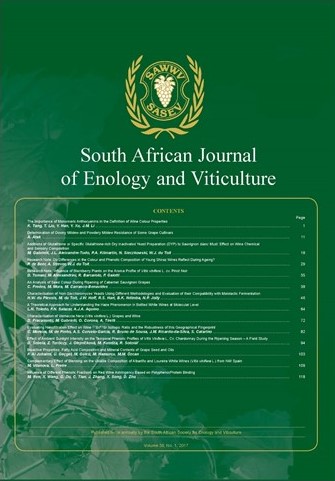Characterisation of Non-Saccharomyces Yeasts Using Different Methodologies and Evaluation of their Compatibility with Malolactic Fermentation
DOI:
https://doi.org/10.21548/38-1-819Abstract
Although Saccharomyces cerevisiae is the yeast species predominantly used for alcoholic fermentation, non-Saccharomyces yeast species are also important because they produce secondary metabolites that can contribute to the final flavour and taste of wines. In this study, 37 strains representing seven non-Saccharomyces species were characterised and evaluated for potential use in wine production, as well as for their effects on malolactic fermentation (MLF). Contour-clamped homogeneous electric field (CHEF) gel electrophoresis and matrix-assisted laser desorption ionisation using a time-of-flight mass spectrometer (MALDI-TOF MS) were used to verify species identity and to determine intra-species variation. Extracellular enzyme production, malic acid degradation and the fermentation kinetics of the yeasts were also investigated. CHEF karyotyping and MALDI-TOF MS were useful for identifying and typing Hanseniaspora uvarum, Lachancea thermotolerans, Candida zemplinina (synonym: Starmerella bacillaris) and Torulaspora delbrueckii strains. Only H. uvarum and Metschnikowia pulcherrima strains were found to have β-glucosidase activity. M. pulcherrima strains also had protease activity. Most of the strains showed limited malic acid degradation, and only Schizosaccharomyces pombe and the C. zemplinina strains showed mentionable degradation. In synthetic wine fermentations, C. stellata, C. zemplinina, H. uvarum, M. pulcherrima and Sc. pombe strains were shown to be slow to medium fermenters, whereas L. thermotolerans and T. delbrueckii strains were found to be medium to strong fermenters. The effect of the yeasts on MLF varied, but inhibition was strain dependent.Downloads
Downloads
Published
Issue
Section
License
A copyright form will be e-mailed to the corresponding author when the manuscript has been accepted for publication.
In principle, the Author agrees to the following when he/she signes the copyright agreement:
I hereby assign to the SOUTH AFRICAN SOCIETY FOR ENOLOGY AND VITICULTURE (SASEV) the copyright of the text, tables, figures, supplementary material, illustrations and other information (the Material) submitted with the manuscript to be published in SOUTH AFRICAN JOURNAL OF ENOLOGY AND VITICULTURE (SAJEV) (the "Article"). The copyright becomes effective from the date the Article has been accepted for publication in SAJEV.
This is an open access journal, and the authors and journal should be properly acknowledged, when works are cited.
Author's may use the publishers version for teaching purposes, in books, theses, dissertations, conferences and conference papers.
A copy of the authors' publishers version may also be hosted on the following websites:
- Non-commercial personal webpage or blog.
- Institutional webpage.
- Authors Institutional Repository.
The following notice should accompany such a posting on the website: This is an electronic version of an article published in SAJEV, Volume XXX, number XXX, pages XXX - XXX, DOI. Authors should also supply a hyperlink to the original paper or indicate where the original paper (www.journals.ac.za/index.php/sajev/) may be found.
Authors publishers version, affiliated with the Stellenbosch University will be automatically deposited in the University's Institutional Repository SUNScholar.
Articles as a whole, may not be re-published with another journal.
The following license applies:
Attribution CC BY-NC-ND 4.0

